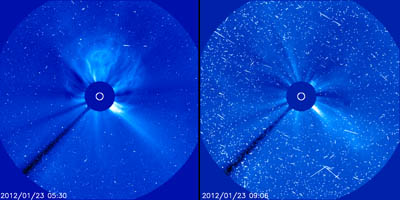Peter Rosén in Sweden captured the aurora produced from the geomagnetic storm on the night of January 24-25. Rosén shared the image with NASA. Image courtesy: NASA / Peter Rosén
The solar storm that collided with planet Earth’s magnetic field on 24-25 January, the largest since 2005, illuminated the skies with stunning aurorae that could be seen by those in the northern latitudes such as Sweden. And even earnest stargazers in Ireland were given an auroral fix this week, as people flocked to places such as Inishowen in Donegal in droves to catch some Northern Lights!
This year seems destined to be a particularly unusual year for the Northern Lights, with scientists predicting that people in lower latitudes might be lucky enough to glimpse them.
Each year stargazers traditionally descend upon areas in the northern latitudes such as Alaska and Scandinavia to stake out the aurora borealis. But, because the sun is almost about to reach its solar maximum ( potentially May 2013) Ireland and other countries could be in with an even better chance of witnessing the aurora borealis this year.
Solar maximum
And another effect of the sun reaching its solar peak is that solar storms are going to be more prevalent this year.
“I would expect that we will see more storms like this one or even bigger as we get closer to solar maximum,” said Michael Hesse, chief of heliophysics at NASA’s Goddard Space Flight Center, this week.
According to the NOAA Space Weather Prediction Center in the US, this week’s geomagnetic storm was the largest since 2005.
The solar storm, marked by an M8.7 soft X-ray flare and the eruption of a fast coronal mass ejection (CME), began early on 23 January.
Scientists and astronomers are gearing up for increased solar storm activity such as what the planet experienced this week. Solar storms themselves don’t pose a threat to humankind. What they can affect, however, is telecommunications such as electricity grids, GPS systems and radio signals. That’s why airlines such as Delta and United Airlines opting to reroute some of their flights in the inter-polar regions this week.
Such solar storms can also affect astronauts.

Snow on the windshield. Solar particle storm impacted Planet Earth on 24/25 January. An M8.7 soft X-ray flare and the eruption of a fast coronal mass ejection (CME), began early on January 23, 2012, igniting the most intense solar energetic particle storm since 2005 – image courtesy of the Solar & Heliospheric Observatory
Electrons and protons traveelled almost at speed of light
SOHO, the Solar & Heliospheric Observatory, said the CME sparked off by the solar flare on 23 January ignited the “most intense solar energetic particle storm” since 2005.
“The expanding CME drove a shock through the solar wind, analogous to a bow wave in front of a fast moving vessel.”
It said that electrons and protons were “accelerated to nearly the speed of light”.
When the “shock” reached Earth, SOHO described the CME particles as spiralling down the magnetic field lines near Earth’s poles, causing “spectacular” aurora displays in the higher latitudes, with some observers claiming it was the best display they’d seen in many years.
SOHO itself is an international collaboration project between the European Space Agency and NASA.